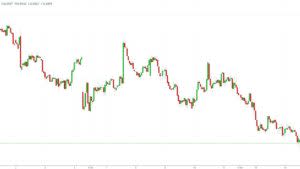The Australian dollar closes at multi-year lows ahead of today's key jobs report
The Australian dollar fell against most major crosses again on Wednesday.
The AUD/USD closed at the lowest level since January 2016.
Weak Chinese and Australian economic data contributed to the AUD's slide.
Australia's April jobs report will be released on Thursday. It's now the most important domestic data release when it comes to the outlook for RBA policy rates.
The Australian dollar continues to slide, closing at fresh multi-month lows against the greenback on Wednesday.
Here's the scoreboard at 7am AEST on Thursday.
AUD/USD 0.6927 , -0.0014 , -0.20%
AUD/JPY 75.9 , -0.17 , -0.22%
AUD/CNH 4.7811 , -0.0101 , -0.21%
AUD/EUR 0.6181 , -0.0008 , -0.13%
AUD/GBP 0.5392 , 0.0015 , 0.28%
AUD/NZD 1.0551 , -0.0001 , -0.01%
AUD/CAD 0.9308 , -0.0041 , -0.44%
In what's fast becoming a familiar theme, the Aussie weakened against all major crosses except the British pound during the session, failing to garner any support despite a further modest improvement in investor risk appetite.
The AUD/USD lost ground throughout Asian and European trade, eventually bottoming out at .6915 before rebounding modestly towards the close.
At .6927, the AUD/USD closed at the lowest level since January 20, 2016.
The release of weak Australian and Chinese economic data ensured the Aussie remained under pressure.
Not even speculation over additional Chinese stimulus, weak US economic data nor signs of easing trade tensions between the US and EU were enough to reverse the Aussie's earlier losses.
"The line of least resistance for the AUD remains down," said David de Garis, economist at the National Australia Bank.
Image: Investing.com
Turning to Thursday's trading, the main event in Asia, at least outside any trade headlines or tweets, will be the release of Australia's April jobs report at 11.30am AEST.
Given the RBA believes that only a further improvement in labour market conditions will likely be enough to bring underlying inflation back to the bottom of its 2-3% target range, this report is now the most important data release in Australia when it comes the outlook for official interest rate settings.
Markets are looking for an increase in employment of 15,000, leaving the unemployment rate steady at 5%.
This 10-second guide has more on what to look out for in this key report.
Outside of Australia, Chinese new home price data for April is the only other major reelase in Asia. It'll arrive at the same time as the Aussie jobs report.
Later in the session, Eurozone trade, Italian CPI along with building permits, housing starts, jobless claims and the Philadelphia Fed manufacturing survey are the main highlights in Europe and North America.

 Yahoo Finance
Yahoo Finance 

